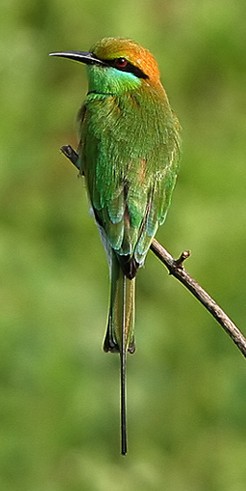|
| 질의: Small white | 결과: 1260번째/2237 | |
Little Green Bee-eater (Merops orientalis) - Wiki
| 제목: | Little Green Bee-eater (Merops orientalis) - Wiki
| |

| 해상도: 246x491
파일크기: 27943 Bytes
등록시간: 2007:09:10 10:42:45
|
Little Green Bee-eater
From Wikipedia, the free encyclopedia
[Photo] Small Green Bee-eater, Merops orientalis. Photographed by S. M. Jayanth in Coimbatore, Tamilnadu, India. November 2005
The Little Green Bee-eater, Merops orientalis, is a near passerine bird in the bee-eater family Meropidae. It is resident in a belt across sub-Saharan Africa from Senegal and The Gambia to Ethiopia, the Nile valley, western Arabia and Asia through India to Vietnam.
This species should not be confused with the Little Bee-eater, Merops pusillus. Migration is limited to seasonal movements depending on rainfall patterns.
Like other bee-eaters, this species is a richly coloured, slender bird. It always has green upper parts, but the head and underpart colours vary widely depending on the subspecies. Thus, southeast Asian birds have rufous crown and face, and green underparts, whereas Arabian breeders have a green crown, blue face and bluish underparts. The wings are green and the beak is black. It reaches a length of 16-18 cm, including the two elongated central tail feathers. These elongated tail feathers are absent in juveniles. Sexes are alike.
This is an abundant and fairly tame bird, familiar throughout its range. It is a bird which breeds in open country with bushes. In Africa and Arabia it is found in arid areas, but is more catholic in its habitats further east. Just as the name suggests, bee-eaters predominantly eat insects, especially bees, wasps and ants, which are caught in the air by sorties from an open perch. This species often hunts from low perches, maybe only a metre or less high. They readily make use of fence wires and electric wires. Before eating its meal, a bee-eater removes the sting by repeatedly hitting the insect on a hard surface.
Unlike most bee-eaters, these are often solitary nesters, making a tunnel in sandy banks. The breeding pairs are often joined by helpers. They sometimes form small colonies, or nest near other bee-eaters. They lay 4 to 8 spherical white eggs. Both the male and the female take care of the eggs. These birds roost communally, lined up on a tree branch. The call is a soft trill.
A study showed that Little Green Bee-eaters are capable of identifying with the behavior other animals. They were able to predict whether a predator at a particular location would be capable of spotting their nest entrance and then behaved appropriately in disguising their location. The ability to look at a situation from another's point of view was previously believed to be possessed only by primates.
http://en.wikipedia.org/wiki/Little_Green_Bee-eater
| The text in this page is based on the copyrighted Wikipedia article shown in above URL. It is used under the GNU Free Documentation License. You may redistribute it, verbatim or modified, providing that you comply with the terms of the GFDL. |
|
댓글 |
|---|
| | 손님 |
|
Scientific Name: Merops orientalis Latham, 1802
Common Names: Asian Green Bee-eater, Guêpier d'Orient, Green Bee-eater (when lumped with M. viridissimus and M. cyanophrys), Little Green Bee-eater
French: Guêpier d’Orient German: Asiensmaragdspint Spanish: Abejaruco esmeralda oriental
Taxonomy: Merops orientalis Latham, 1801, Mahratta, India. |
^o^
동물그림창고 똑똑전화 누리집
^o^
|
|
|